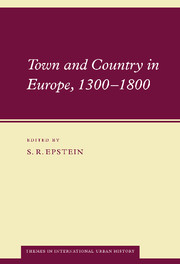Book contents
- Frontmatter
- Contents
- List of figures
- List of tables
- Notes on the contributors
- 1 Introduction. Town and country in Europe, 1300–1800
- 2 Town and country in Sweden, 1450–1650
- 3 Town and country in Holland, 1300–1550
- 4 Town and country in the Dutch Republic, 1550–1800
- 5 Town and country in England, 1300–1570
- 6 Town and country in England, 1570–1750
- 7 Town and country in the Polish Commonwealth, 1350–1650
- 8 Town and country in the Austrian and Czech lands, 1450–1800
- 9 Town and country in Germany, 1350–1600
- 10 Town and country in Switzerland, 1450–1750
- 11 Town and country in France, 1550–1750
- 12 Town and country in Castile, 1400–1650
- 13 Town and country in central and northern Italy, 1400–1800
- 14 Town and country in the kingdom of Naples, 1500–1800
- Index
7 - Town and country in the Polish Commonwealth, 1350–1650
Published online by Cambridge University Press: 09 November 2009
- Frontmatter
- Contents
- List of figures
- List of tables
- Notes on the contributors
- 1 Introduction. Town and country in Europe, 1300–1800
- 2 Town and country in Sweden, 1450–1650
- 3 Town and country in Holland, 1300–1550
- 4 Town and country in the Dutch Republic, 1550–1800
- 5 Town and country in England, 1300–1570
- 6 Town and country in England, 1570–1750
- 7 Town and country in the Polish Commonwealth, 1350–1650
- 8 Town and country in the Austrian and Czech lands, 1450–1800
- 9 Town and country in Germany, 1350–1600
- 10 Town and country in Switzerland, 1450–1750
- 11 Town and country in France, 1550–1750
- 12 Town and country in Castile, 1400–1650
- 13 Town and country in central and northern Italy, 1400–1800
- 14 Town and country in the kingdom of Naples, 1500–1800
- Index
Summary
Introduction
During the fourteenth century new prospects opened up for east-central Europe. Poland, Bohemia, Hungary and Lithuania underwent intensive economic development, consolidated and strengthened their polities, and initiated a period of external expansion. In 1340 the newly united Polish state began a struggle to succeed the disintegrating duchies of the western Rus’. Lithuania gained vast tracts of the northern Rus’ and Kievan Duchy. A union between Poland and Lithuania, formed in 1385 and made permanent in 1569, created one of the biggest states in Europe at the time, known as the Commonwealth of the Two Nations, which by 1500 covered 1,140,000 km2, of which the territory of the Polish crown accounted for only 255,000 km2. The Commonwealth extended from the Baltic to the Black Sea and from the Carpathian mountains to the outskirts of Moscow. It formed a vast cultural frontier between the Latin West and the Byzantine and Orthodox East, and after the Turks expanded into Europe it also became a gate to the Muslim world. The Commonwealth also displayed considerable internal diversity. Poland, especially its eastern lands, included a particularly heterogeneous mixture of ethnic groups, religions and cultures, with corresponding differences in development ranging from simple barter economies to sophisticated forms of market exchange.
Although Poland was rich in land, this was not the main source of the country's wealth. The most important natural resource for a feudal economy was men, and Poland was one of the most sparsely populated countries in Europe.
- Type
- Chapter
- Information
- Town and Country in Europe, 1300–1800 , pp. 156 - 175Publisher: Cambridge University PressPrint publication year: 2001



